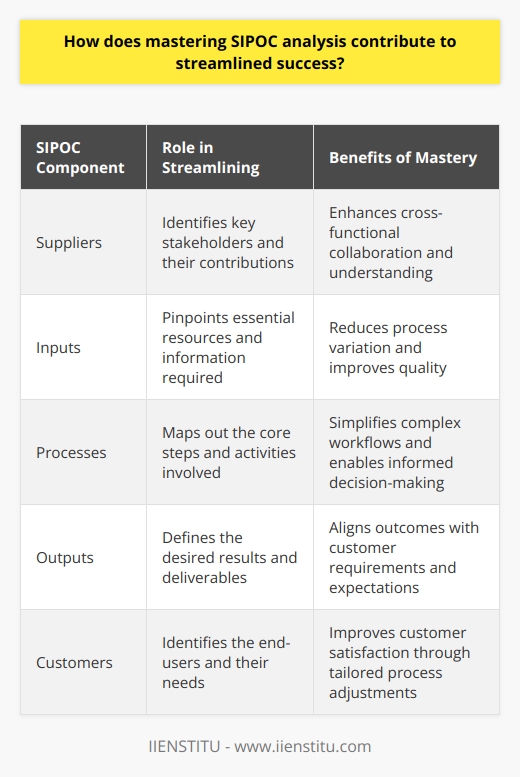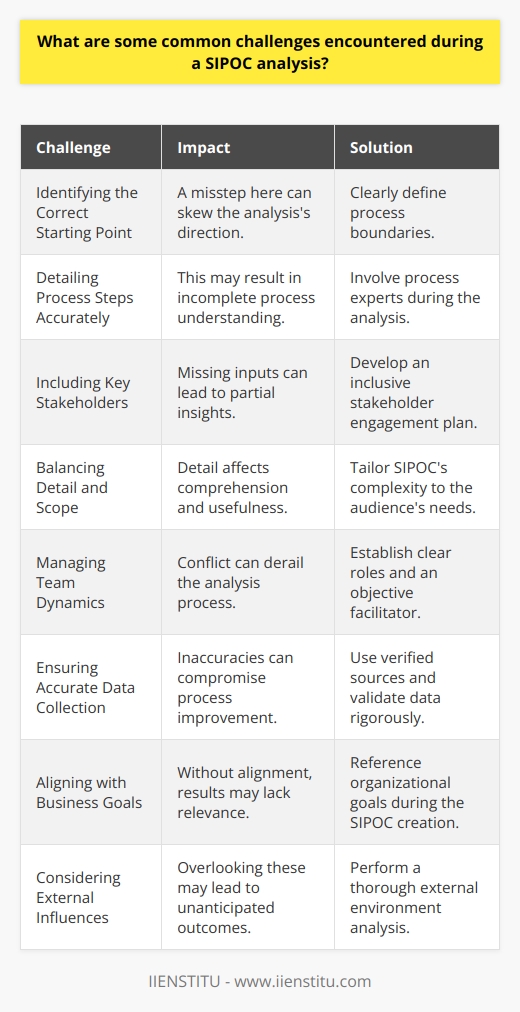
Analyzing and streamlining business processes is crucial for enhancing efficiency and building a successful organization. SIPOC Analysis stands at the forefront of these efforts, providing a structured approach to deeply understand processes and their variables.
Mastering SIPOC not only positions a company to refine operations but also to react adaptively to changes in the business environment. In this article, we unpack SIPOC Analysis' depth, offering insights for professionals looking to excel in process improvement within their organizations.
🔊 Ready for an auditory reading experience? Just click the 'Play' button right below this text and immerse yourself in our captivating audio version. Ideal for those who prefer listening to stories, or for times when you're multitasking. Engage with our content effortlessly - one simple click is all it takes to transform your reading into listening!
Introduction to SIPOC Analysis
Definition and Significance of SIPOC Analysis
SIPOC Analysis is a high-level, visual tool used for documenting a business process from start to finish. It stands for Suppliers, Inputs, Process, Outputs, and Customers – each representing a critical phase in the lifecycle of a product or service. By mapping these components, businesses can visualize the process flow and identify areas of waste and inefficiency. The significance of SIPOC Analysis cannot be overstated; it provides a concise framework for initiating process improvements and fostering business efficiency.
The Role of SIPOC in Achieving Streamlined Success
In the realm of achieving streamlined success, SIPOC Analysis serves as a foundational pillar. It illuminates the inner workings of business processes, offering clear insights into how each stage contributes to the overall outcome. This mastery of process intricacies permits organizations to execute strategies for enhancement with higher precision, leading to continuous improvement and success that is both streamlined and sustainable.
How Mastering SIPOC Can Enhance Business Efficiency
Mastering SIPOC Analysis is a cornerstone for any professional or organization serious about enhancing business efficiency. It incorporates a holistic view of the process, enabling leaders to identify redundancies and streamline workflows effectively. By applying SIPOC principles, stakeholders can ensure that every element of the process is aligned with the organization's objectives, thus facilitating a more agile and responsive operational structure.
The Fundamentals of SIPOC Analysis
Understanding the SIPOC Acronym
What does SIPOC Stand for?
The acronym SIPOC symbolizes the five key elements that comprise any business process. Suppliers provide the inputs; Inputs are the resources needed; the Process is the set of actions taken; Outputs are the results of the process; and Customers are the recipients. Each element is interdependent and requires careful analysis to ensure they synergize efficiently.
The Historical Development of SIPOC Analysis
SIPOC Analysis has evolved from quality management practices, particularly those espoused within the Total Quality Management and Six Sigma methodologies. The tool has gained traction for its simplicity and effectiveness, offering a framework that can be understood across various levels of an organization.
The Importance of Each Component in Process Improvement
Suppliers - The Starting Point of Any Process
Suppliers are critical as they set the stage for the inputs that define the quality and constraints of the process. Appropriate selection and management of suppliers are vital for maintaining consistency and meeting the standards required for a successful output.
Inputs - The Essential Resources Required
Inputs include materials, information, and any other resource needed to drive the process. Their quality and availability are crucial; hence, organizations must ensure that inputs are accurately defined and controlled.
Process - The Sequence of Steps to Transform Inputs to Outputs
The Process involves the steps or stages that transform inputs into outputs. A well-defined process can reduce waste, prevent errors, and enhance efficiency. SIPOC Analysis is instrumental in documenting and refining these steps, enabling a more streamlined operation.
Outputs - The Resulting Products or Services
Outputs are the end products or services that are delivered to the Customers. SIPOC Analysis helps to ensure that these are in line with customer expectations and quality standards, contributing to greater customer satisfaction and loyalty.
Customers - The Ultimate Recipients and their Needs
Customers are the judge of a process's success. SIPOC Analysis foregrounds their needs and expectations, allowing businesses to align outputs accordingly and deliver value that fosters ongoing patronage.
Illustrative Examples of SIPOC Components in Various Industries
Application of SIPOC is ubiquitous across various sectors. In manufacturing, SIPOC can map the journey of raw material to finished product; in services, it could trace client request fulfillment. Each industry can draw valuable insights from SIPOC analysis, optimizing unique processes that contribute to industry-specific achievements.
The Step-by-Step Guide to Performing SIPOC Analysis
Identifying the Process for SIPOC Analysis
Choosing the Right Process to Examine
Not all processes benefit equally from SIPOC Analysis. It is essential to identify core processes that have a significant impact on operational efficiency and customer satisfaction. These processes are typically the best candidates for SIPOC Analysis.
Scope Definition and Boundary Setting
Defining the scope of the process and setting its boundaries is crucial for effective SIPOC Analysis. This delineation aids in concentrating efforts and resources on areas that are most likely to yield meaningful enhancements.
How to Collect and Document SIPOC Information
Efficient Data Gathering Techniques
Collecting information for SIPOC Analysis requires an organized approach. Techniques such as interviews, workshops, and direct observation are commonly used. These methods help in amassing data that is detailed and representative of the actual process.
Tools for Visualizing SIPOC (Flowcharts, Diagrams, etc.)
Visualization is a powerful aspect of SIPOC Analysis. Tools like flowcharts and diagrams facilitate a clearer understanding of the process. They provide a reference point that stakeholders can collectively examine and collaborate on.
Team Involvement in SIPOC Construction
Roles and Responsibilities in SIPOC Development
Clear delineation of roles and responsibilities is vital for constructing an accurate SIPOC model. Each team member should understand their contribution and how it fits into the larger picture of the analysis.
Encouraging Cross-functional Collaboration
SIPOC Analysis benefits from cross-functional collaboration. Involving members from different departments ensures a more holistic view of the process, uncovering insights that might otherwise be missed. This collaborative approach enriches the analysis and fosters a sense of ownership and commitment to the subsequent improvements.
Validating and Refining the SIPOC Model
Methods for Ensuring SIPOC Accuracy
Accuracy in SIPOC Analysis is non-negotiable. Applying methods such as cross-verification with process stakeholders and iterative reviews can ensure that the SIPOC model accurately reflects the process.
Iterative Review and Continuous Improvement
Even after initial validation, the SIPOC model may require refinements. This iterative process is integral to continuous improvement, allowing businesses to adapt their processes to changing circumstances and maintain efficiency.
Leveraging SIPOC Analysis for Streamlined Business Success
Utilizing SIPOC for In-depth Process Understanding
An in-depth understanding of processes is a prerequisite for streamlining. SIPOC Analysis is instrumental in developing this comprehensive knowledge, thereby setting the groundwork for significant business success.
The Impact of SIPOC on Organizational Communication and Clarity
Clear communication and clarity within the organization are often byproducts of effective SIPOC Analysis. By having a shared understanding of processes, employees can work more synergistically, breaking down silos and promoting a more coherent organizational culture.
Case Studies: Real-world Applications and Outcomes
Various case studies have shown that the application of SIPOC Analysis resulted in quantifiable improvements. For example, a manufacturing company may have streamlined its production process, leading to reduced waste and faster turnaround times, exemplifying the tangible benefits of mastering SIPOC Analysis.
Common Challenges in SIPOC Analysis and Solutions
Avoiding Oversimplification and Inaccuracy
One major challenge in SIPOC Analysis is the temptation to oversimplify complex processes, leading to inaccuracies. It's crucial to balance simplicity with detail, ensuring that the analysis is both accessible and accurate. Regular validation with process experts can help mitigate these issues.
Addressing Resistance to Change within the Organization
Resistance to change is an expected obstacle when implementing new process improvements. Successful SIPOC Analysis incorporates change management principles to help ease transitions and secure buy-in from stakeholders.
Best Practices for Ensuring Sustained Use and Effectiveness
To ensure the sustained effectiveness of SIPOC Analysis, it is critical to institutionalize it as part of the organization's continuous improvement culture. Ongoing training, reinforcement, and adaptation of the tool can lead to long-term benefits and prevent it from becoming merely a one-time exercise.
Advanced Tips and Strategies for Mastering SIPOC
Integrating SIPOC with Other Process Improvement Methodologies
Mastering SIPOC Analysis involves recognizing its potential for integration with other methodologies like Lean and Six Sigma. This integration can enhance the robustness of process improvement initiatives, providing a more comprehensive approach to achieving operational excellence.
Scaling SIPOC for Complex Processes and Large Organizations
Scaling SIPOC for use in complex processes or within large organizations requires a thoughtful approach. It involves breaking down large processes into smaller, manageable segments and ensuring that the analysis maintains its relevance across different departments and functions.
Continuous Learning and Adaptation in Process Analysis
The landscape of business is ever-changing, necessitating continuous learning and adaptation in process analysis. Professionals dedicated to mastering SIPOC should stay abreast of new developments, tools, and techniques in the field, incorporating them into their practice to remain effective.
The Essential Role of SIPOC in Achieving Business Efficiency
The essential role of SIPOC in fostering business efficiency is undeniable. This tool provides a blueprint for understanding, analyzing, and improving business processes, which is fundamental to organizational success.
Recap of the Steps to Master SIPOC Analysis
To master SIPOC Analysis, it's crucial to understand the significance of each component, identify the right processes, collect and document information efficiently, construct the SIPOC model with team involvement, and continually refine the analysis for accuracy and improvement.
The Path Forward: Continuous Improvement through SIPOC
Continuous improvement is the essence of process excellence, and SIPOC Analysis is a vehicle for this journey. As organizations strive to enhance their operations, SIPOC will remain an indispensable tool for diagnosing process health and initiating impactful changes.
Encouraging Readers to Begin Their SIPOC Journey
We encourage readers to take the bold first step on their SIPOC journey. Whether through on-the-job application, participating in a problem solving course free, or enrolling in an online mba course, the time invested in learning and mastering SIPOC Analysis is a cornerstone for personal and organizational growth.
Suggestions for Further Learning and Resource Exploration
For those seeking to deepen their understanding of SIPOC Analysis and process improvement, a wealth of resources is available. Professional networking groups, online forums, and educational materials can provide further insights into the practical aspects of SIPOC Analysis. Engaging in continuous learning and resource exploration will not only bolster one's expertise but will also contribute to the overall advancement of streamlined business success.
Frequently Asked Questions
What are the key components of a SIPOC analysis?
Understanding SIPOC Analysis
SIPOC analysis stands as a powerful tool. It structures project planning and processes. Central to Six Sigma methodology, it aids in process improvement. SIPOC breaks down into five components. These elements signify the various steps in a process.
Suppliers (S)
Suppliers launch the SIPOC cycle. They provide the initial inputs. These entities could be internal or external. Quality input is crucial. It sets the stage for the following phases.
Inputs (I)
Inputs form the raw materials. They transition from suppliers to the process. Consistency in inputs is key. It aids in maintaining process stability. Variances can derail output quality.
Process (P)
The process acts as the transformation stage. Here, inputs convert into outputs. It involves a sequence of steps. Each follows the other logically. Documenting these steps in sequence matters. It helps identify bottlenecks.
Outputs (O)
Outputs are the end products. They result from the process. These should meet or exceed customer expectations. The quality of outputs reflects the process's efficacy.
Customers (C)
Customers are the recipients of outputs. They drive the demand for the outputs. Their needs dictate the process design. Feedback from customers guides improvements.
The Significance of Each Component
A thorough SIPOC analysis requires attention to detail. Each component's role is distinctive. Yet, all interconnect within the broader process.
Suppliers must align with process requirements. Inputs necessitate careful selection. They impact the entire process flow. Processes require constant evaluation. This ensures they function efficiently. Outputs warrant regular quality checks. They demonstrate the process's value. Customers offer insights and feedback. They encourage continuous improvement.
Applying SIPOC Analysis
Identify relevant suppliers. Assess the quality of inputs. Map out each process step carefully. Evaluate outputs against standards. Gather customer feedback consistently.
These steps establish a robust understanding. They aid in pinpointing improvement areas. SIPOC analysis equips teams with a clear overview. It allows for targeted, impactful enhancements.
SIPOC analysis is a cornerstone in process management. It provides a snapshot of the process lifecycle. Clarity and simplicity are its strengths. Applying it thoughtfully ensures operational excellence. It aligns organizational processes with customer needs. SIPOC serves as a blueprint for systematic improvement.

How does mastering SIPOC analysis contribute to streamlined success?
Understanding SIPOC Analysis
SIPOC analysis stands for Suppliers, Inputs, Processes, Outputs, and Customers. It forms a high-level map of an existing business process. Through SIPOC, stakeholders gain a comprehensive overview. This aligns teams on the essential elements. Clear communication about the process components is a result.
Role in Streamlining Processes
Mastering SIPOC drives business efficiency. It pinpoints areas of waste and delay. Team members can then see non-value-adding steps. They focus on optimizing the core process elements. The outcomes align with customer requirements. This leads to better resource utilization.
Benefits of SIPOC Proficiency
Simplification of Complex Processes
Proficiency in SIPOC transforms complex workflows. It breaks down intricate steps into simpler components. Key stakeholders can better understand the flow of work. This clarity promotes informed decision-making.
Enhanced Communication Among Stakeholders
Clear communication is a direct result. Teams can discuss their needs with a common understanding. It allows for better collaboration. Stakeholders know their roles and dependencies.
Reduction in Process Variation
Consistency becomes achievable with SIPOC. It delineates the necessary inputs and expected outputs. Unnecessary variations reduce. Quality improvements are the natural outcome.
Improved Customer Satisfaction
SIPOC links processes to customer needs. It ensures the final output meets expectations. Customer satisfaction sees a significant boost. Stakeholder needs dictate process adjustments.
Better Cross-functional Collaboration
Departments often operate in silos. SIPOC breaks down these barriers. It facilitates cross-functional collaboration. Teams understand upstream and downstream impacts. Organizational effectiveness increases.
Practical Steps for Mastering SIPOC
- Start with thorough training
- Practice on existing processes
- Involve all key stakeholders
- Seek regular feedback
- Iterate and refine continually
Mastering SIPOC analysis fosters streamlined success. Stakeholders align with clear, shared process understanding. Efficiency and customer satisfaction improve. It is indispensable for continuous improvement. Commit to SIPOC for effective and streamlined operations.

What are some common challenges encountered during a SIPOC analysis?
Understanding SIPOC Analysis
SIPOC stands for Suppliers, Inputs, Process, Outputs, and Customers. It serves as a process mapping tool in quality management, especially within Six Sigma methodologies. Professionals use it to map all relevant elements of a process improvement project before work begins. However, several challenges can arise during a SIPOC analysis.
Identifying the Correct Starting Point
Challenge: Knowing where to begin.
Impact: A misstep here can skew the analysis's direction.
Solution: Clearly define process boundaries.
Detailing Process Steps Accurately
Challenge: Overlooking vital steps within the process.
Impact: This may result in incomplete process understanding.
Solution: Involve process experts during the analysis.
Including Key Stakeholders
Challenge: Ensuring all stakeholders are involved.
Impact: Missing inputs can lead to partial insights.
Solution: Develop an inclusive stakeholder engagement plan.
Balancing Detail and Scope
Challenge: Avoiding too much or too little detail.
Impact: Detail affects comprehension and usefulness.
Solution: Tailor SIPOC's complexity to the audience's needs.
Managing Team Dynamics
Challenge: Navigating differing opinions and expertise.
Impact: Conflict can derail the analysis process.
Solution: Establish clear roles and an objective facilitator.
Ensuring Accurate Data Collection
Challenge: Gathering precise and reliable data.
Impact: Inaccuracies can compromise process improvement.
Solution: Use verified sources and validate data rigorously.
Aligning with Business Goals
Challenge: Connecting the analysis to strategic objectives.
Impact: Without alignment, results may lack relevance.
Solution: Reference organizational goals during the SIPOC creation.
Considering External Influences
Challenge: Accounting for external factors.
Impact: Overlooking these may lead to unanticipated outcomes.
Solution: Perform a thorough external environment analysis.
Facilitating Change Management
Challenge: Preparing for the organizational change.
Impact: Resistance can occur without proper transition planning.
Solution: Develop a proactive change management strategy.
Achieving Comprehensive Understanding
Challenge: Ensuring a shared vision among all participants.
Impact: Misunderstandings can cause misalignment in the process.
Solution: Utilize visual tools and collaborative discussions.
Maintaining Flexibility
Challenge: Staying adaptable to new information.
Impact: Rigidity can prevent effective process improvement.
Solution: Review and adjust the analysis as necessary.
Documenting and Communicating Findings
Challenge: Effectively recording and sharing results.
Impact: Poor communication can limit the benefits of SIPOC.
Solution: Use clear documentation and communication strategies.
In conclusion, SIPOC analysis provides a strong foundation for process improvement. Nevertheless, practitioners must navigate various challenges to ensure success. By addressing these hurdles with thorough planning and open communication, teams can leverage SIPOC to drive meaningful quality improvements.



